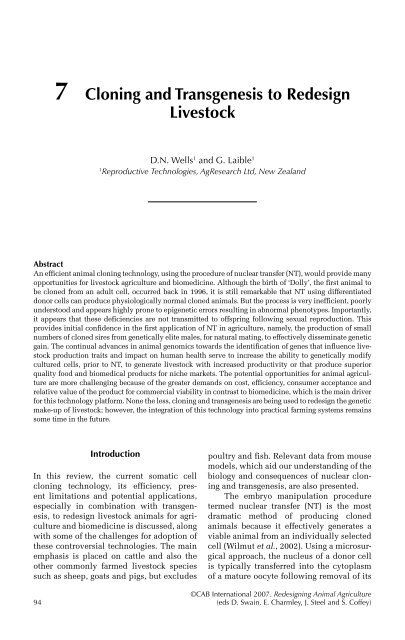Redesigning Animal Agriculture
Redesigning Animal Agriculture
Redesigning Animal Agriculture
Create successful ePaper yourself
Turn your PDF publications into a flip-book with our unique Google optimized e-Paper software.
7 Cloning and Transgenesis to Redesign<br />
Livestock<br />
D.N. Wells 1 and G. Laible 1<br />
1 Reproductive Technologies, AgResearch Ltd, New Zealand<br />
Abstract<br />
An efficient animal cloning technology, using the procedure of nuclear transfer (NT), would provide many<br />
opportunities for livestock agriculture and biomedicine. Although the birth of ‘Dolly’, the first animal to<br />
be cloned from an adult cell, occurred back in 1996, it is still remarkable that NT using differentiated<br />
donor cells can produce physiologically normal cloned animals. But the process is very inefficient, poorly<br />
understood and appears highly prone to epigenetic errors resulting in abnormal phenotypes. Importantly,<br />
it appears that these deficiencies are not transmitted to offspring following sexual reproduction. This<br />
provides initial confidence in the first application of NT in agriculture, namely, the production of small<br />
numbers of cloned sires from genetically elite males, for natural mating, to effectively disseminate genetic<br />
gain. The continual advances in animal genomics towards the identification of genes that influence livestock<br />
production traits and impact on human health serve to increase the ability to genetically modify<br />
cultured cells, prior to NT, to generate livestock with increased productivity or that produce superior<br />
quality food and biomedical products for niche markets. The potential opportunities for animal agriculture<br />
are more challenging because of the greater demands on cost, efficiency, consumer acceptance and<br />
relative value of the product for commercial viability in contrast to biomedicine, which is the main driver<br />
for this technology platform. None the less, cloning and transgenesis are being used to redesign the genetic<br />
make-up of livestock; however, the integration of this technology into practical farming systems remains<br />
some time in the future.<br />
Introduction<br />
In this review, the current somatic cell<br />
cloning technology, its efficiency, present<br />
limitations and potential applications,<br />
especially in combination with transgenesis,<br />
to re design livestock animals for agriculture<br />
and biomedicine is discussed, along<br />
with some of the challenges for adoption of<br />
these controversial technologies. The main<br />
emphasis is placed on cattle and also the<br />
other commonly farmed livestock species<br />
such as sheep, goats and pigs, but excludes<br />
poultry and fish. Relevant data from mouse<br />
models, which aid our understanding of the<br />
biology and consequences of nuclear cloning<br />
and transgenesis, are also presented.<br />
The embryo manipulation procedure<br />
termed nuclear transfer (NT) is the most<br />
dramatic method of producing cloned<br />
animals because it effectively generates a<br />
viable animal from an individually selected<br />
cell (Wilmut et al., 2002). Using a microsurgical<br />
approach, the nucleus of a donor cell<br />
is typically transferred into the cytoplasm<br />
of a mature oocyte following removal of its<br />
©CAB International 2007. <strong>Redesigning</strong> <strong>Animal</strong> <strong>Agriculture</strong><br />
94 (eds D. Swain, E. Charmley, J. Steel and S. Coffey)










